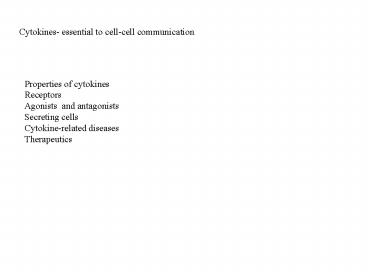Cytokines essential to cellcell communication - PowerPoint PPT Presentation
1 / 29
Title:
Cytokines essential to cellcell communication
Description:
Are assigned to families based on structure; four families ... non-physiological conditions and at. non-physiological concentrations. No cytokine acts alone ... – PowerPoint PPT presentation
Number of Views:45
Avg rating:3.0/5.0
Title: Cytokines essential to cellcell communication
1
Cytokines- essential to cell-cell communication
Properties of cytokines Receptors Agonists and
antagonists Secreting cells Cytokine-related
diseases Therapeutics
2
Effective at very low concentrations
Tend to work locally (p. 277)
3
Attributes of cytokines (p. 278)
4
Cascade effect (p. 278)
5
Activity was noted long before cytokines
could be isolated Present in very small
amounts Hard to characterize Process was helped
along by gene cloning technology cytokine-depen
dent cell lines monoclonal antibodies
6
General structure of cytokines Small (lt30
kD) Are assigned to families based on
structure four families identified so far
7
- Summary of (some) functions
- Regulate hematopoiesis
- Colony-stimulating factors
- IL-3 can cause many types of cells to divide
- IL-7 differentiation into pre-B and pre-T cells
2. Innate immune responses IL-1, IL-6, TNF-?,
INF-? and INF-? produced mostly by
macrophages and neutrophils fever, acute-phase
response, recruit leukocytes to site of damage
8
Cytokines and hematopoiesis (p. 297)
Table p. 296
9
3. Inflammation all of the above (part
2) IFN-?- activates macrophages TGF-?-
terminates inflammatory response 4. Specific
immune responses IL-2 T cell growth factor IL-4
T and B cells IL-5 and IL-6 B cell proliferation
and differentiation 5. Chemokines attract
leukocytes IL-8 RANTES (see Ch. 12 for more
extensive list)
10
See partial summary p. 281
11
Be advised Most of these activities were
described in non-physiological conditions and
at non-physiological concentrations No cytokine
acts alone Many act in cascades not always
clear which is the real effector Many are
pleiotropic How is this activity regulated?
12
Cytokine receptors Cytokines must bind to
specific receptors to activate cells A
particular type of receptor may be expressed on
many cells Families of receptors
13
Immunoglobulin Class I cytokine receptor Class
II TNF receptor Chemokine
14
These vary in Structure Distribution Can be
sorted into categories because they have
characteristic structures Many cytokines
involved in immune and hematopoietic function
are class I
15
Class I and class II receptors tend to
have multiple subunits one involved in binding
and one in signal transduction Signal
trasnduction subunit may be common to many
16
Cytokine class I receptor subfamiliy
Cytokine-specific subunit Common
signal-transducing subunit (?) (p. 283)
17
Three forms of the IL-2 receptor
18
General model for Class I and II receptors
19
Cytokine antagonists- two mechanisms Inhibitor
binds to receptor and blocks it (e.g.,
IL-1Ra) Soluble receptors bind to cytokines
so they cant bind to membrane-bound receptors
(soluble IL-2 receptor among many others
released in chronic T-cell activation)
20
Viruses never give up!
21
TH1 and TH2 subsets secrete different cytokines
TH1- cell-mediated functions inflammation TH2-
humoral immunity
22
p. 288
23
TH1 and TH2 subsets regulate each other
24
p. 289
25
Cytokine-related diseases
Bacterial septic shock endotoxins (cell walls)
stimulate production of IL-1 and TNF-? Cancers
of lymphoid system- overproduction of cytokines
such as IL-6 (B-cell) or IL-5 (Hodgkins
disease) or IL-2 (adult T-cell leukemia) Chagas
disease (parasitic)- suppression of ?-subunit
of IL-2 receptor
26
Cytokine therapies Interferons IFN-?- certain
types of tumors IFN-?- multiple
sclerosis these are antiviral IFN-?- chronic
granulomatous disease IL-2- certain types of
cancer infusion LAK (lymphokine-activated
killer) cells TILs (tumor-infiltrating
lymphocytes) GM-CSF- immune deficiencies
27
TNF (tumor necrosis factors) TNF-? and ? In
some cases inhibit proliferation of tumor cells
but not normal cells May damage vascular
endothelial cells in tumors, thus inhibiting
blood supply to the tumor
28
Strategies to modulate the immune response
e.g., to reduce graft rejection (p. 293)
29
Toxin-conjugated cytokines kill TH cells and
prevent graft rejection Problems rapidly
cleared from system can be very toxic doses are
hard to control Possible solutions ex vivo
cell culture conjugate cytokines to other
molecules modify cytokines?































